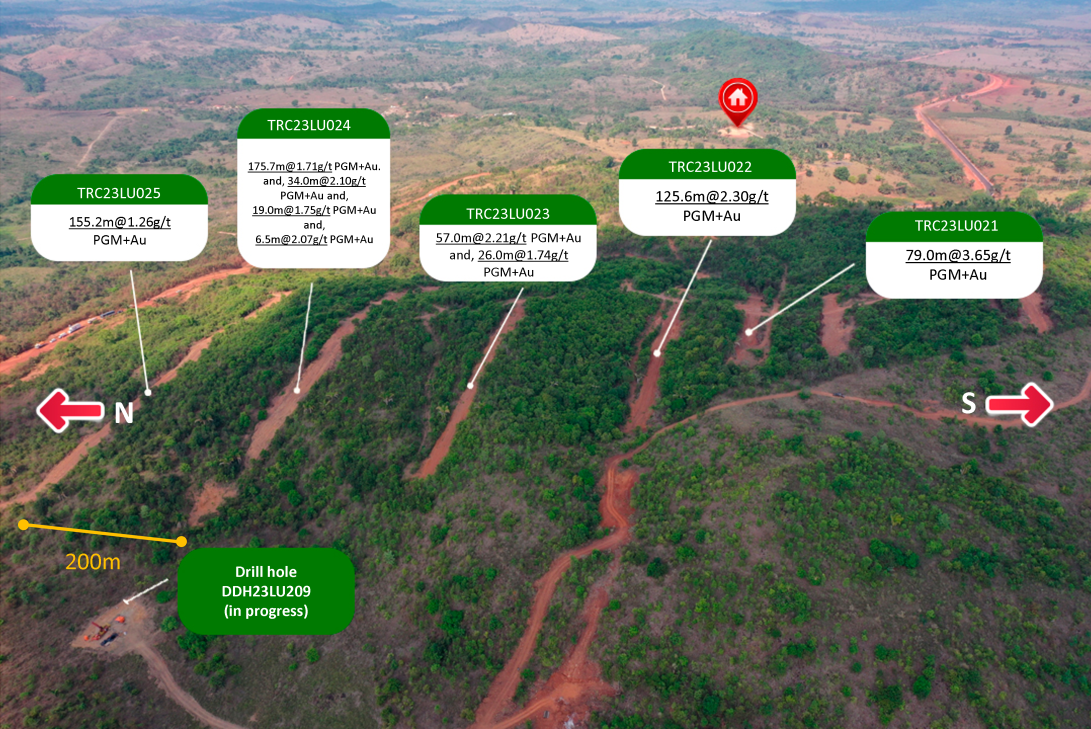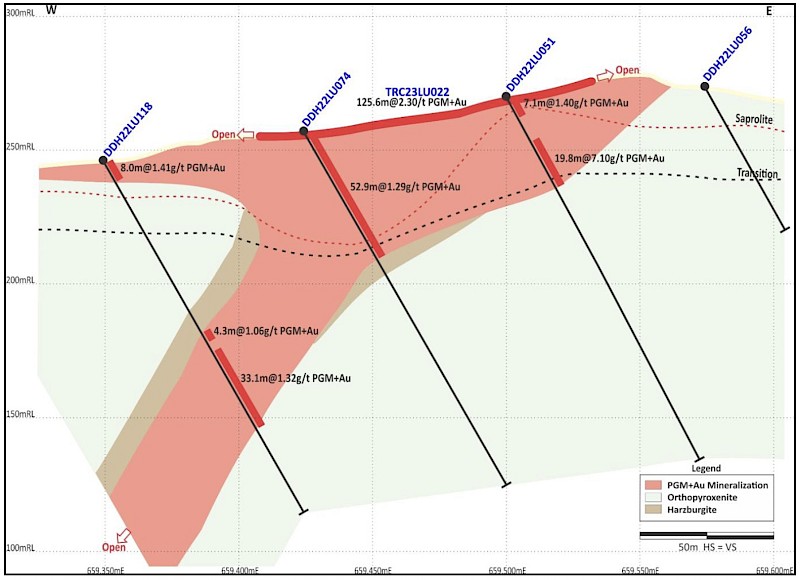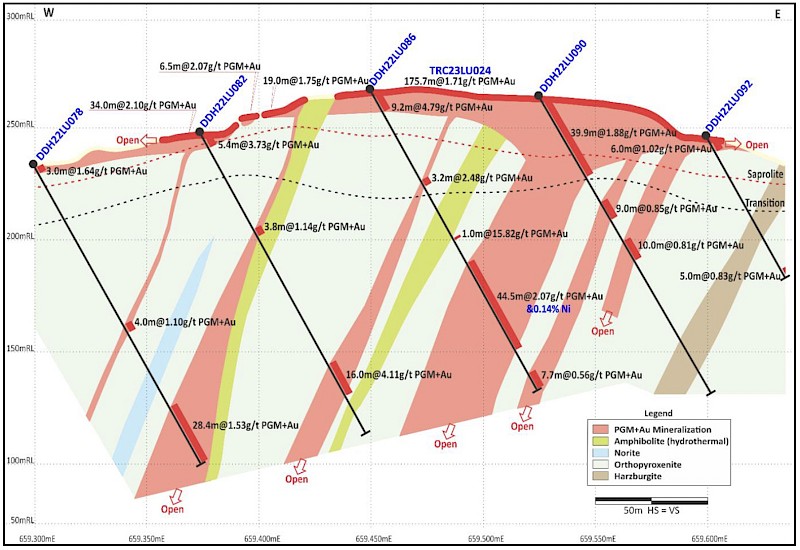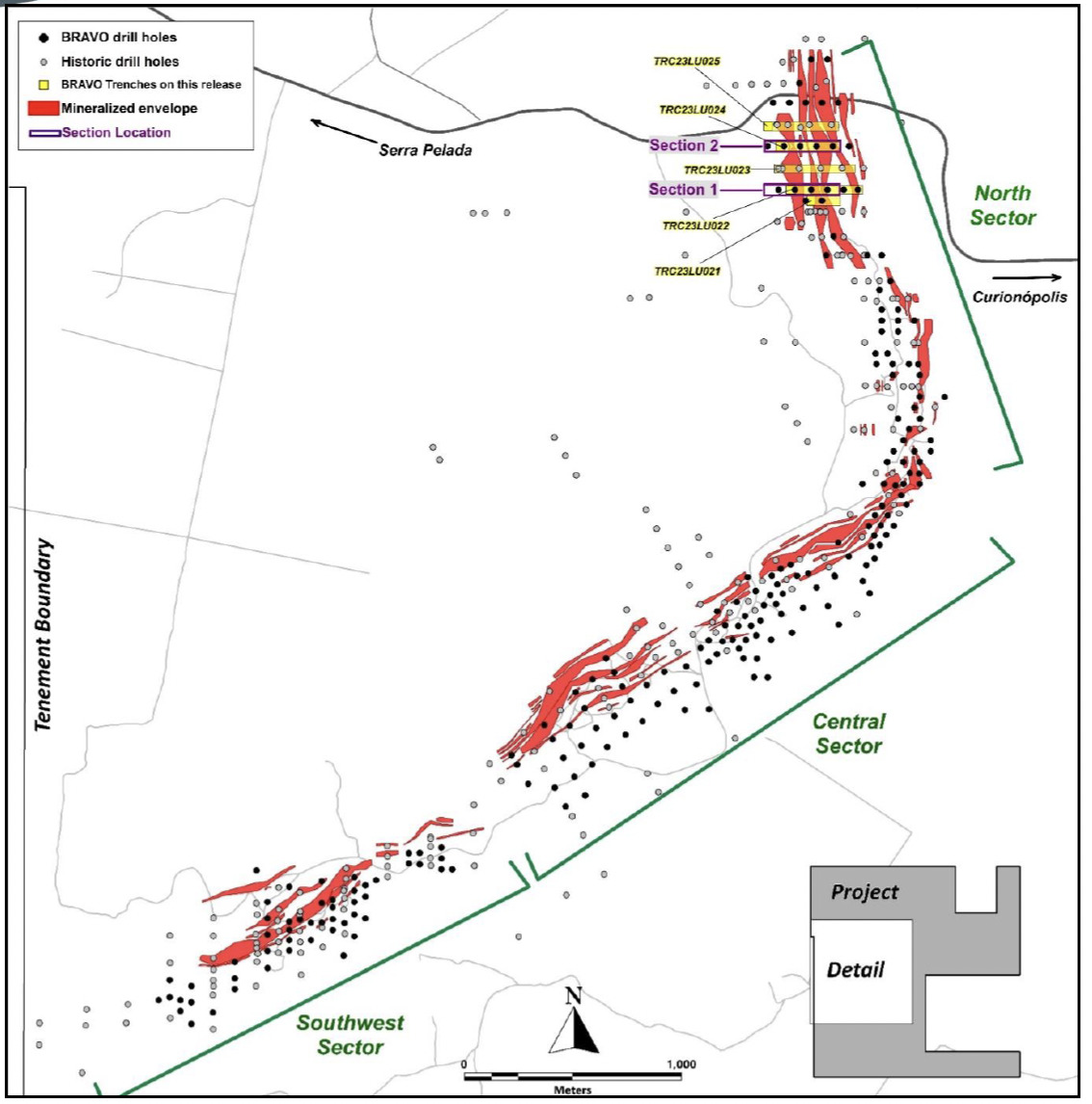Highlights include 79m at 3.65g/t PGM+Au, including 22m at 9.40g/t PGM+Au; 125m at 2.30g/t PGM+Au; and 175m at 1.71g/t PGM+Au, including 30m at 3.47g/t PGM+Au
VANCOUVER, September 26, 2023 – Bravo Mining Corp. (TSX.V: BRVO, OTCQX: BRVMF), (“Bravo” or the “Company”) announced that it has received assay results from a further five trenches, all located in the North Sector of its 100% owned Luanga palladium + platinum + rhodium + gold + nickel project (“Luanga” or “Luanga PGM+Au+Ni Project”), located in the Carajás Mineral Province, state of Pará, Brazil.
“Our trenching program continues to yield outstanding results and highlights the lateral extension of Oxide PGM+Au mineralization at surface, now observed in both the North and Southwest Sectors. Results show the potential for increased volume and improved average grades in the oxide zone, which are expected to have a positive impact on the oxide component of the forthcoming Mineral Resource Estimate,” said Luis Azevedo, Chairman and CEO of Bravo. “Furthermore, the assay grades returned within the trenches are consistently higher than the assay grades in the nearest drill holes located below the trenches. This supports our interpretation of supergene enrichment occurring in the near-surface oxide zone.”
Highlights Include:
- The successful program of trenching, which commenced at Luanga’s Southwest Sector, aimed at improving the interpretation of mineralization at surface for the pending Mineral Resource Estimate (“MRE”), continues to progress in the North Sector, again returning excellent results and showing significant upside potential in both volume and the grade of mineralization.
- Further potential is yet to be tested since some trenches are still in mineralization at their end/s and require extension. For example, mineralization in trench TRC23LU022 is open at each end of the trench, with both ends finishing in the highest-grade mineralization within the greater 125m wide interval:
- 0m (Start of Trench) to 9m @ 5.62g/t PGM+Au; and
- 117m to 125.6m (End of Trench) @ 4.66g/t PGM+Au.
- Trenching is planned to continue along the entire 8.1km strike length of the Luanga deposit.
|
TRENCH-ID |
From |
To |
Thickness |
Pd |
Pt |
Rh |
Au |
PGM + Au |
TYPE |
|---|---|---|---|---|---|---|---|---|---|
|
TRC23LU021 |
0.0 |
79.0 |
79.0 |
2.05 |
1.24 |
0.23 |
0.13 |
3.65 |
Ox |
|
Including |
29.0 |
51.0 |
22.0 |
5.09 |
3.28 |
0.62 |
0.41 |
9.40 |
Ox |
|
TRC23LU022 |
0.0 |
125.6 |
125.6 |
1.01 |
1.16 |
0.11 |
0.02 |
2.30 |
Ox |
|
TRC23LU023 |
100.0 |
157.0 |
57.0 |
1.24 |
0.79 |
0.11 |
0.06 |
2.21 |
Ox |
|
TRC23LU024 |
0.0 |
34.0 |
34.0 |
0.51 |
1.52 |
0.05 |
0.01 |
2.10 |
Ox |
|
And |
82.5 |
258.2 |
175.7 |
1.04 |
0.56 |
0.09 |
0.02 |
1.71 |
Ox |
|
Including |
93.5 |
123.5 |
30.0 |
2.23 |
1.02 |
0.20 |
0.03 |
3.47 |
Ox |
|
TRC23LU025 |
32.0 |
187.2 |
155.2 |
0.77 |
0.53 |
0.04 |
0.02 |
1.36 |
Ox |
|
Including |
73.0 |
110.0 |
37.0 |
1.16 |
0.96 |
0.10 |
0.04 |
2.26 |
Ox |
Notes: All ‘From’, ‘To’ depths, and ‘Thicknesses’ are along the topographic surface.
Type: Ox = Oxide. FR = Fresh Rock. Recovery methods and results will differ based on the type of mineralization.
Luanga Trenching Program
The successful program of trenching that commenced at Luanga’s Southwest Sector in 2022, has continued in the North Sector (Figure 1). Trenching across the strike of the outcrop/sub-crop aims to better interpret near surface mineralization for the pending MRE, and to reduce the distance/spacing between assay data points in preparation for MRE classification (i.e., Indicated/Inferred).
The trenching program continues to highlight significant growth in the extent of shallow mineralization, which is supported by thicknesses intersected in shallow drillholes nearby. Assay results from trenching (sections shown in Figures 2 & 3) clearly show that mineralization in the saprolite zone (above the base of oxidation) increases in thickness, a feature that is common in tropical weathering profiles. Figure 4 shows the location of trenches, and their mineralized thicknesses in plan. PGM grades in the trench assay samples compare positively to the high-grade intersections in nearby down dip drillholes (Figures 2 & 3). This supports the concept of supergene enrichment in the saprolite zone, as reported in previous trench results (see May 08th, 2023).

Figure 1: Trenching in the North Sector.
The saprolite zone ranges from <2m thick on the ridge line, to 25m thick away from the ridge. When taking into account the wider than expected high-grade trench results, the evidence of near surface supergene enrichment and the Luanga deposit’s 8.1km of strike, there is potential for a substantially greater volume of saprolite zone/oxide mineralization at higher than historically modelled grades, and potentially greater metal content in the pending maiden MRE.
The same sampling, assay laboratory procedures and QAQC protocols as applied to drill core sampling are applied to trench samples.
Trenching to date continues to be successful, beneficial, and highly cost effective. Trenching is planned to continue along the entire 8.1km strike length of the Luanga deposit, moving to the Central Sector after completion in the North Sector.
Figure 2 (Section 1) shows how trenching has significantly improved the definition and volume potential of near surface oxide mineralization, while improving the understanding of the relationship between near surface oxide mineralized intersections in Bravo’s drilling. Previously, the up-dip portion of the mineralized section was interpreted more conservatively; however, trench data provides strong support for an improved interpretation.
In the case of trench TRC23LU022 (Figure 2), mineralization is also still open at each end of the trench, signalling the potential for further improvement when the trench is extended. Furthermore, both ends of the trench finished in the highest-grade portions of the trench: 0m (Start of Trench) to 9m grading 5.62g/t PGM+Au and 117m to 125.6m (End of Trench) grading 4.66 g/t PGM+Au.
Figure 2: North Sector (Section 1 on Figure 4) – Trenching demonstrating potential for volume growth near surface, in the saprolite.
Trench TRC23LU024 (Figure 3, Section 2) was opened to evaluate the previously interpretation of mineralization; however, it is now clear that a significant blanket of mineralized oxide exists not just on top of the ridge but persisting down both sides of the ridge. With multiple zones of mineralization in the trench, one of which is 175m wide, the trench’s extensions are yet to be tested in both directions. Assay grades encountered in the trench are once again higher than assay grades in nearest drill holes below the trench, further supporting the existence of supergene enrichment in the near surface oxide material.
In summary, firstly Bravo sees potential for MRE volume growth due to a more extensive oxide blanket covering the entire ridge coincident with the mineralized zone and extending down both sides of the ridge. Secondly, Bravo sees further potential for volume growth due the “mushroom” style expansion of mineralization in the saprolite zone directly above the main mineralized zones and extending beyond the trench limits. Further, there is the potential to continue to encounter higher average grades in the oxide mineralization due to the continuing evidence of supergene enrichment near surface.
Figure 3: North Sector (Section 2 on Figure 4) – Trenching improves definition of volume and understanding of mineralization at surface.
Luanga Drilling Status
A total of 215 drill holes (80 in 2023) have been completed by Bravo to date, for 44,110 metres, including 8 planned twin holes and 8 metallurgical holes (not subject to routine assaying). Results have been reported for 186 Bravo drill holes to date. Results for 21 Bravo drill holes are currently outstanding (excluding the 8 metallurgical holes).
Complete Table of Recent Intercepts - Trenching
|
TRENCH-ID |
From |
To |
Thickness |
Pd |
Pt |
Rh |
Au |
PGM + Au |
TYPE |
|---|---|---|---|---|---|---|---|---|---|
|
TRC23LU021 |
0.0 |
79.0 |
79.0 |
2.05 |
1.24 |
0.23 |
0.13 |
3.65 |
Ox |
|
Including |
29.0 |
51.0 |
22.0 |
5.09 |
3.28 |
0.62 |
0.41 |
9.40 |
Ox |
|
TRC23LU022 |
0.0 |
125.6 |
125.6 |
1.01 |
1.16 |
0.11 |
0.02 |
2.30 |
Ox |
|
Including |
0.0 |
9.0 |
9.0 |
2.36 |
3.19 |
0.04 |
0.03 |
5.62 |
Ox |
|
Also Including |
117.0 |
125.6 |
8.6 |
2.79 |
1.50 |
0.27 |
0.10 |
4.66 |
Ox |
|
TRC23LU023 |
4.0 |
30.0 |
26.0 |
0.56 |
1.13 |
0.04 |
0.01 |
1.74 |
Ox |
|
And |
100.0 |
157.0 |
57.0 |
1.24 |
0.79 |
0.11 |
0.06 |
2.21 |
Ox |
|
TRC23LU024 |
0.0 |
34.0 |
34.0 |
0.51 |
1.52 |
0.05 |
0.01 |
2.10 |
Ox |
|
And |
38.0 |
44.5 |
6.5 |
0.40 |
1.60 |
0.06 |
0.01 |
2.07 |
Ox |
|
And |
48.5 |
67.5 |
19.0 |
0.61 |
1.04 |
0.08 |
0.01 |
1.75 |
Ox |
|
And |
82.5 |
258.2 |
175.7 |
1.04 |
0.56 |
0.09 |
0.02 |
1.71 |
Ox |
|
Including |
93.5 |
123.5 |
30.0 |
2.23 |
1.02 |
0.20 |
0.03 |
3.47 |
Ox |
|
TRC23LU025 |
32.0 |
187.2 |
155.2 |
0.77 |
0.53 |
0.04 |
0.02 |
1.36 |
Ox |
|
Including |
73.0 |
110.0 |
37.0 |
1.16 |
0.96 |
0.10 |
0.04 |
2.26 |
Ox |
Notes: All ‘From’, ‘To’ depths, and ‘Thicknesses’ are along the topographic surface.
Type: Ox = Oxide. FR = Fresh Rock. Recovery methods and results will differ based on the type of mineralization.
Figure 4: Location of Bravo Trenches and Sections Reported in this News Release
About Bravo Mining Corp.
Bravo is a Canadian and Brazil-based mineral exploration and development company focused on advancing its Luanga PGM+Au+Ni Project in the world-class Carajás Mineral Province of Brazil.
The Luanga Project benefits from being in a location close to operating mines, with excellent access and proximity to existing infrastructure, including road, rail, and clean and renewable hydro grid power. A fully funded 63,000m infill, step out and exploration drilling is currently underway. Bravo’s current Environmental, Social and Governance activities includes replanting trees in the project area, hiring and contracting locally, and ensuring protection of the environment during its exploration activities.
Technical Disclosure
Technical information in this news release has been reviewed and approved by Simon Mottram, F.AusIMM (Fellow Australia Institute of Mining and Metallurgy), President of Bravo Mining Corp. who serves as the Company’s “qualified person” as defined in National Instrument 43-101 Standards of Disclosure for Mineral Projects (“NI 43-101”). Mr. Mottram has verified the technical data and opinions contained in this news release.
For further information about Bravo, please visit www.bravomining.com or contact:
Alex Penha
EVP Corporate Development
info@bravomining.com
Forward Looking Statements
This news release contains forward-looking information which is not comprised of historical facts. Forward-looking information is characterized by words such as “compare well”, “elevated”, “expect”, “anticipated”, “future results”, “continue”, “outstanding results”, “positive impact”, “potential”, “successful”, “interpretation”, variants of these words and other similar words, phrases, or statements that certain events or conditions “may”, “should” or “will” occur. This news release contains forward-looking information pertaining to the Company’s ongoing trenching program; the interpretation of the results of trench data, including that the mineralization thickens in the saprolite, is locally supergene enriched, and the impact on mineral resource estimates thereof; the potential that similar thickening and supergene enrichment may be present along the entire strike length of the Luanga deposit and the impact on mineral resource estimates thereafter; the potential for additional mineralization once trenches are extended beyond their current limits and the impact on mineral resource estimates thereafter; the potential future economics of the saprolite material, including the recoverability of PGMs and Au therein; the results of planned additional trenching;; the timing and outcome of the planned mineral resource estimate; and the Company’s plans in respect thereof. Forward-looking information involves risks, uncertainties and other factors that could cause actual events, results, and opportunities to differ materially from those expressed or implied by such forward-looking information. Factors that could cause actual results to differ materially from such forward-looking information include, but are not limited to, unexpected results from exploration programs, changes in the state of equity and debt markets, fluctuations in commodity prices, delays in obtaining required regulatory or governmental approvals, environmental risks, limitations on insurance coverage; and other risks and uncertainties involved in the mineral exploration and development industry. Forward-looking information in this news release is based on the opinions and assumptions of management considered reasonable as of the date hereof, including, but not limited to, the assumption that the assay results confirm that the interpreted mineralization contains significant values of nickel, PGMs and Au; that the mineralization remains open to depth, that Ni grades are improving to depth, that final drill and assay results will be in line with management’s expectations; that activities will not be adversely disrupted or impeded by regulatory, political, community, economic, environmental and/or healthy and safety risks; that the Luanga Project will not be materially affected by potential supply chain disruptions; and general business and economic conditions will not change in a materially adverse manner. Although the Company believes that the assumptions and factors used in preparing the forward-looking information in this news release are reasonable, undue reliance should not be placed on such information. The Company disclaims any intention or obligation to update or revise any forward-looking information, other than as required by applicable securities laws.
Schedule 1: Trench Location Details
|
HOLE-ID |
Company |
East |
North |
RL |
Datum |
Length |
Azimuth |
Dip |
Sector |
|---|---|---|---|---|---|---|---|---|---|
|
TRC23LU021 |
Bravo |
659499.99 |
9343025.66 |
271.220 |
SIRGAS2000 UTM22S |
101.30 |
90.00 |
0.00 |
North |
|
TRC23LU022 |
Bravo |
659407.24 |
9343076.19 |
253.380 |
SIRGAS2000 UTM22S |
125.64 |
90.00 |
0.00 |
North |
|
TRC23LU023 |
Bravo |
659350.83 |
9343172.01 |
242.000 |
SIRGAS2000 UTM22S |
157.00 |
90.00 |
0.00 |
North |
|
TRC23LU024 |
Bravo |
659357.00 |
9343275.63 |
241.313 |
SIRGAS2000 UTM22S |
258.17 |
90.00 |
0.00 |
North |
|
TRC23LU025 |
Bravo |
659299.87 |
9343366.60 |
232.210 |
SIRGAS2000 UTM22S |
245.00 |
90.00 |
0.00 |
North |
Schedule 2: Assay Methodologies and QAQC
Samples follow a chain of custody between collection, processing, and delivery to the SGS laboratory in Parauapebas, state of Pará, Brazil. The drill core is delivered to the core shack at Bravo’s Luanga site facilities and processed by geologists who insert certified reference materials, blanks, and duplicates into the sampling sequence. Drill core is half cut and placed in secured polyurethane bags, then in security-sealed sacks before being delivered directly from the Luanga site facilities to the Parauapebas SGS laboratory by Bravo staff. Additional information about the methodology can be found on the SGS Geosol website (SGS) in their analytical guides. Information regarding preparation and analysis of historic drill core is also presented in the table below, where the information is known.
Quality Assurance and Quality Control (“QAQC”) is maintained internally at the lab through rigorous use of internal certified reference materials, blanks, and duplicates. An additional QAQC program is administered by Bravo using certified reference materials, duplicate samples and blank samples that are blindly inserted into the sample batch. If a QAQC sample returns an unacceptable value an investigation into the results is triggered and when deemed necessary, the samples that were tested in the batch with the failed QAQC sample are re-tested.
|
Bravo SGS Geosol |
||||
|---|---|---|---|---|
|
Preparation |
Method |
Method |
Method |
Method |
|
For All Elements |
Pt, Pd, Au |
Rh |
Sulphide Ni, Cu |
Trace Elements |
|
PRPCLI (85% at 200#) |
FAI515 |
FAI30V |
AA04B |
ICP40B |



